
Kazimierz is a historical district of Kraków and Kraków Old Town, Poland. From its inception in the 14th century to the early 19th century, Kazimierz was an independent city, a royal city of the Crown of the Polish Kingdom, located south of the Old Town of Kraków, separated from it by a branch of the Vistula river. For many centuries, Kazimierz was a place where ethnic Polish and Jewish cultures coexisted and intermingled. The northeastern part of the district was historically Jewish. In 1941, the Jews of Kraków were forcibly relocated by the German occupying forces into the Krakow ghetto just across the river in Podgórze, and most did not survive the war. Today, Kazimierz is one of the major tourist attractions of Krakow and an important center of cultural life of the city.

Josefov is a town quarter and the smallest cadastral area of Prague, Czech Republic, formerly the Jewish ghetto of the town. It is surrounded by the Old Town. The quarter is often represented by the flag of Prague's Jewish community, a yellow Magen David on a red field.
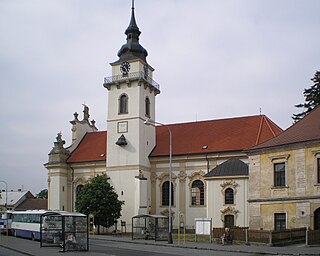
Heřmanův Městec is a town in Chrudim District in the Pardubice Region of the Czech Republic. It has about 5,000 inhabitants. The historic town centre with the castle complex is well preserved and is protected by law as an urban monument zone.

The history of the Jews in Prague, the capital of today's Czech Republic, relates to one of Europe's oldest recorded and most well-known Jewish communities, first mentioned by the Sephardi-Jewish traveller Ibrahim ibn Yaqub in 965 CE. Since then, the community has existed continuously, despite various pogroms and expulsions, the Holocaust, and subsequent antisemitic persecution by the Czech Communist regime in the 20th century.

The history of the Jewish community of Venice, which is the capital of the Veneto region of Italy has been well known since the medieval era.

The Dohány Street Synagogue, also known as the Great Synagogue or Tabakgasse Synagogue, is a Neolog Jewish congregation and synagogue, located on Dohány Street in Erzsébetváros of Budapest, Hungary. It is the largest synagogue in Europe, seating 3,000 people, and is a centre of Neolog Judaism. The congregation worships in the Ashkenazi rite.

The Frankfurter Judengasse was the Jewish ghetto of Frankfurt and one of the earliest ghettos in Germany. It existed from 1462 until 1811 and was home to Germany's largest Jewish community in early modern times.
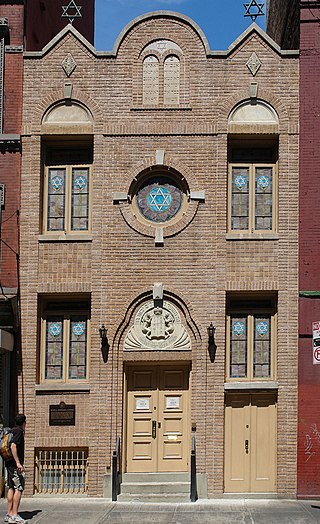
Kehila Kedosha Janina is a synagogue located at 280 Broome Street between Allen and Eldridge Streets in the Lower East Side neighborhood of Manhattan, New York City, New York, United States.
The history of the Jews in Turin, Italy, can be first traced to the 4th century when bishop Maximus of Turin recorded the presence of Jews in the city. The city of Turin is in north-west Italy and is the capital of the Piedmont region.

In the early modern era, European Jews were confined to ghettos and placed under strict regulations as well as restrictions in many European cities. The character of ghettos fluctuated over the centuries. In some cases, they comprised a Jewish quarter, the area of a city traditionally inhabited by Jews. In many instances, ghettos were places of terrible poverty and during periods of population growth, ghettos had narrow streets and small, crowded houses. Residents had their own justice system. Around the ghetto stood walls that, during pogroms, were closed from inside to protect the community, but from the outside during Christmas, Pesach, and Easter Week to prevent the Jews from leaving at those times.
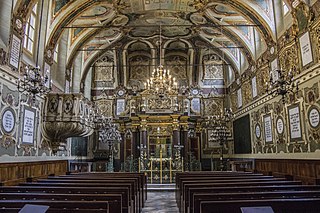
The Synagogue of Casale Monferrato is a 16th-century synagogue located in Vicolo Salmone Olper in the traditionally Jewish quarter of Casale Monferrato, Province of Alessandria, region of Piedmont, Italy.
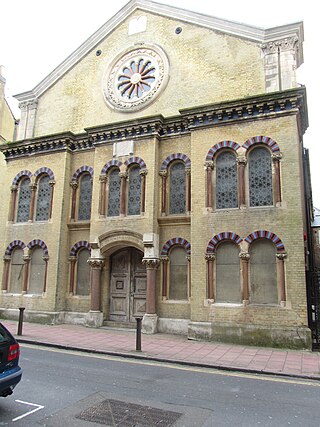
The Middle Street Synagogue is an Orthodox Jewish congregation and synagogue, located at 66 Middle Street, in the centre of Brighton, in the city of Brighton and Hove, Sussex, England, in the United Kingdom. The congregation was formed in c. 1820s as the Brighton Hebrew Congregation and since 1918, was known as the Brighton & Hove Hebrew Congregation, and worshiped in the Ashkenazi rite.

The Cherasco Synagogue is the old synagogue of the Jewish community of Cherasco, Italy.

The Italian Synagogue of Padua is the only synagogue still in use of the several that flourished in the university town of Padua from the Renaissance through World War II.
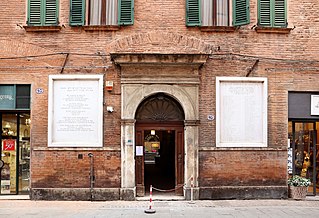
The Ferrara Synagogue is a synagogue located in Ferrara, Italy.

Congregation Beth Israel is a Reform Jewish congregation and synagogue, located in Meridian, Mississippi, in the United States. Founded in 1868 and a member of the Union for Reform Judaism, the congregation's first permanent house of worship was a Middle Eastern-style building constructed in 1879. The congregation moved to another building built in the Greek Revival style in 1906, and in 1964 moved to a more modern building, out of which they still operate.
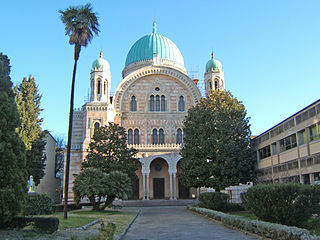
The history of the Jews in Florence can be traced over nine hundred years. Florence is the capital city of the Italian region of Tuscany and of the province of Florence. The Jews of Florence have one of the oldest continuous Jewish communities in Europe. The historic Jewish community in Florence is one of the largest and one of the most influential Jewish communities in Italy. The Jewish community in Florence also serves the smaller neighboring Jewish communities in Pisa, Livorno, and Siena.

The Jewish Museum of Rome is situated in the basement of the Great Synagogue of Rome and offers both information on the Jewish presence in Rome since the second century BCE and a large collection of works of art produced by the Jewish community. A visit to the museum includes a guided tour of the Great Synagogue and of the smaller Spanish Synagogue in the same complex.

The Canton Synagogue is one of five synagogues in the Jewish Ghetto of Venice, Italy. Established only four years after the nearby Scuola Grande Tedesca (1528), it is the second oldest Venetian synagogue. Its origins are uncertain: it might have been constructed as a prayer room for a group of Provençal Jews soon after their arrival in Venice, or as a private synagogue for a prominent local family. Repeatedly remodeled throughout its history, its interior is predominantly decorated in the Baroque and Rococo styles.

The Jewish Museum of Florence is a museum of Jewish history located in the Great Synagogue of Florence, Italy. The museum, which covers two spaces of the building, gathers an important collection of ancient objects of Jewish ceremonial art, evidence of the high artistic level achieved by the Jewish-Italian communities in the field of applied arts. Exhibitions illustrate the history of Florentine Jews from the first settlements to the post-war reconstruction, featuring old photographs, films and a large number of objects of daily and commemorative use.




















